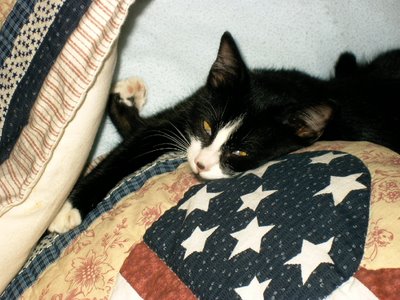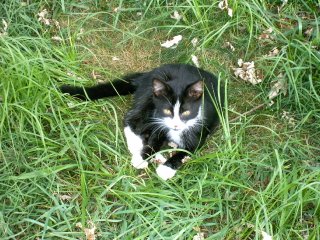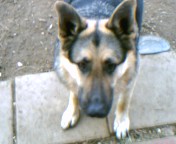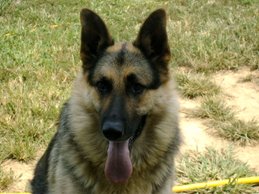I have experienced funny and interesting things with my pets around the holidays. When my husband and I were celebrating our 3rd christmas in Ohio with our new pet, Rockie (a sweet stray cat we had taken in), I remember how transfixed she was by the twinkling lights in the tree. I think she probably logged many hours trying to figure out a way to "catch" all of them at one time!
A few years ago we added another member to the family when we got Wiley, (aka: Fat Boy). His particular fetish if to lick any sort of plastic and eat ribbons off of the gifts. Luckily, we realized what he was going before having to take him to the emergency vet for intestinal obstruction.
Happy Holidays from my barn yard to yours!

Ho, ho, uh-oh! One of my earliest holiday memories is of our cat climbing the Christmas tree, knocking ornaments off all the way.
Most cat owners have probably had a similar experience. Dogs, too, have their own brand of holiday mischief, such as chewing open the gifts or scarfing down Christmas dinner.
The holiday season offers ample opportunity for pets to show their naughty side, leaving some owners to scramble to save the tree, the trimmings or the turkey.
Retired schoolteacher Joanne Nash of Los Altos, Calif., used to decorate her tree with clay-bake ornaments made from flour, salt and water. “I had made some myself, bought some, and had some that my students had made,” she says. Unfortunately for Nash, her Dalmatians thought the ornaments were delicious dog treats, placed on the tree just for them.“Stealthy Dalmatians managed to snatch them one by one when we weren’t in the room with the tree,” Nash recalls. “We replaced the consumed ones with a few more the next year, but some invisible dog stole those too, and we haven’t had any clay-bake ornaments since.”
So Nash has adapted her holiday décor to the realities of life with dogs. Because she breeds Dalmatians and Cavalier King Charles Spaniels, there’s often a puppy or two in the house during the holidays. Although her high ceilings would permit a large tree, she and her husband limit themselves to a smaller one that can be placed atop an old wooden chest, out of reach of curious puppies.
“Even so,” she says, “we don’t do much decorating of the lower branches.”
An elf in the tree
Kirby, a 12-year-old lilac-point Siamese, likes to climb up in the middle of the tree and peer out at passersby, who are understandably startled to see that pointy elfin face suddenly pop through the branches. Kirby’s also fond of eating holiday greenery, which he then vomits up, much to the dismay of his owner, Connie Holmes of Laguna Niguel, Calif.
Kirby’s sister, a tabby-point Siamese named Jazmyn, enjoys eating the ribbons off boxes, a potentially fatal habit, so packages are now plain at the Holmes household.
But Holmes' approach is to take her cats’ antics in stride. “They love Christmas as much as I do,” she says.
The new owner of 118-pound Keisha, a Saint Bernard puppy, adopted just days before Thanksgiving, is learning some strategies that should help her head off trouble this holiday season.“Never turn your back after the tablecloth is on the table, because she’s either on the table or running past it to grab the corner end of great-grandma’s Irish lace and linen to whip it off the table,” says Suzanne Moore of Glide, Ore. As she surfed the Internet for Web sites on repairing antique hand-tatted lace, Moore decided on a new holiday tradition.
“We learned it is much easier and less stressful to give thanks at a table covered with a vinyl tablecloth and set with paper plates that are filled from an improvised buffet on the breakfast bar, which is the only counter high enough that Keisha can’t just sneak by and grab a turkey leg on the run,” Moore says. “And everyone can relax and not worry about gravy and wine stains on a museum-quality tablecloth or fear that someone will chip or break the china. It was a great lesson!”
Some pets don't want to do damage at the holidays; they just want to let us know who’s really in charge. At least, that’s the theory that writer Barbara Florio Graham, of Gatineau, Quebec, Canada, ascribes to the actions of her cat Simon Teakettle, nicknamed Tiki.
Being an experienced cat owner, she collected nonbreakable ornaments for her Christmas tree, among them several sets of crocheted white snowflakes, which she hung on the Norfolk Island pine in her living room.
“Every year, Tiki would watch carefully as I hung these, listen to my admonitions that he was not to touch, and dutifully leave the room,” she says. “And every morning, one single snowflake, its hook still attached, would have been carefully removed from a branch and placed delicately on the rug. It was his way of letting me know who made the actual decisions in the household.”
Creature comfort
Sometimes the accommodations we make for our pets during the holidays benefit us as well as our animals.
“My mother and father are taking care of my 200-pound Neapolitan mastiff, Baby,” says veterinarian Jill Richardson, of Secaucus, N.J. "He loves the Christmas tree so much that they put it up after Halloween and leave it out until Valentine’s Day. He loves to wrap himself around the base of it and sleep. They enjoy this even more than he does because when he’s under the tree, there’s actually room for them to sit on the couch instead of on the floor.”

















